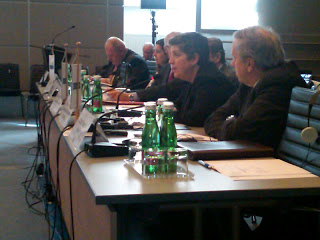Yesterday, Secretary Napolitano visited Minot, North Dakota to see firsthand the damage caused by the recent severe flooding. Her visit follows Deputy Administrator Serino’s visit to Minot on June 29. The Secretary encouraged Minot residents to continue to register for federal disaster assistance and reiterated the federal government's commitment to continue supporting Minot for the long haul. She also encouraged anyone interested in helping the people of Minot and across North Dakota to send donations through organizations like the American Red Cross, the Salvation Army or the Minot Area Recovery Fund.

Minot, ND, July 13, 2011 -- Secretary Janet Napolitano speaks to the media and holds up a sign with the FEMA registration information. She strongly urged affected residents in eligible counties to apply for assistance.
We wanted to provide you with a brief overview of her day -- and her thoughts on helping North Dakota in the long recovery process ahead.
An Aerial Tour
The Secretary began her visit with a helicopter tour over Minot and surrounding areas impacted. She witnessed the extensive flood damage to hundreds of homes, schools, churches, farmland, and other community areas devastated by the disaster.
Learning from Local Leaders

Minot, ND, July 13, 2011 -- Secretary Janet Napolitano listens to Minot Mayor, Curt Zimbelman, at a meeting with North Dakota Gov Jack Dalrymple and local officials after doing an aerial survey of the areas still under water in Minot and surrounding towns. Napolitano and other FEMA officials promised to continue to provide assistance to residents affected by recent floods.
Secretary Napolitano also met with the state and local officials leading the recovery efforts, including Governor Jack Dalrymple, the mayors of Minot and Burlington, and many other local officials. They discussed some of the priorities the state and community are facing as they move forward, such as reopening schools and grocery stores. With so many homes flooded, temporary housing that can withstand the harsh winters of North Dakota is another major concern. The Secretary ensured that the government would work quickly with the state to provide temporary housing to survivors that meets their needs.
A Visit with the Media
After the meeting, the Secretary joined the governor and mayors for a press conference for local media.
Secretary Napolitano thanked the Governor and local officials for their hard work, and explained: "We are all standing behind the people of Minot, behind the people of the surrounding area, and the people of North Dakota… We will make sure that everything that can be done is being done, and is being done as quickly as possible."

Minot, ND, July 13, 2011 -- Secretary Janet Napolitano and North Dakota Governor Jack Dalrymple appear at a press conference with local, state and other federal officials. Napolitano and Dalrymple did an aerial survey of the areas still under water in Minot and the surrounding towns. Napolitano and FEMA officials promised to continue to provide assistance to residents affected by recent floods.
At FEMA, we remain committed to supporting the survivors and local officials in recovering from the devastating floods in Minot. FEMA officials on the ground have been working hard to register survivors for temporary housing assistance, low-interest loans, and other forms of disaster assistance, and we’ll be there as long as it takes to help the Minot community recover and rebuild.
Published by the U.S. Department of Homeland Security, Washington, D.C.
 Official website of the Department of Homeland Security
Official website of the Department of Homeland Security








 Last week, the U.S. Department of Homeland Security’s (DHS) Science and Technology Directorate awarded a SAFETY Act designation to Visual Defence USA, Inc. for its blast-resistant video system designed for use in mass transit vehicles. This marks the first time a product has received both a SAFETY Act designation and a SECURE certification.
Last week, the U.S. Department of Homeland Security’s (DHS) Science and Technology Directorate awarded a SAFETY Act designation to Visual Defence USA, Inc. for its blast-resistant video system designed for use in mass transit vehicles. This marks the first time a product has received both a SAFETY Act designation and a SECURE certification.
